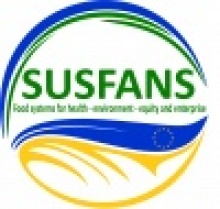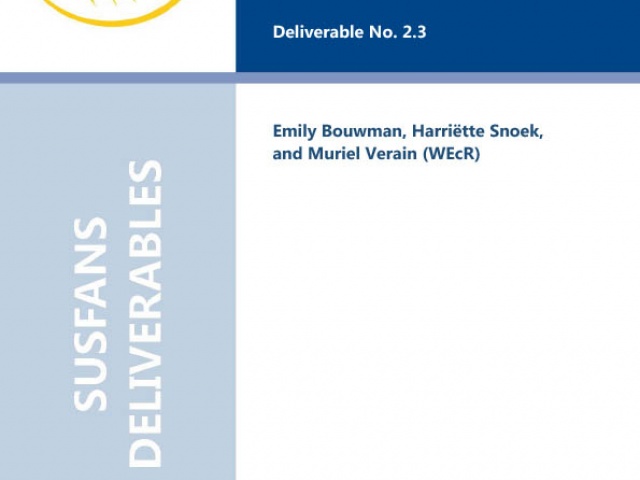
Deliverable 2.3: Analysis of the online choice experiment on fruit and vegetables determining the importance of nutritional and environmental benefits and the level of information
In this deliverable we investigate consumers’ sensitivity to product information on fruit and vegetable products. Fruit and vegetable consumption is associated with better health and prevention of diseases (Guillaumie et al., 2012) and more knowledge is needed on how product information on fruit and vegetable products influences consumer choices. This study contributes to the existing literature by studying the combination of health and sustainability information. In light of dual process theories (ELM; Petty & Cacioppo, 1986; HSM; Chaiken 1980) we took both message content and message characteristics into account.
Take a lookDeliverable 11: Communication Plan
This deliverable embodies the Communication Plan and will report on Task 11.1. The communication plan includes a long list of the future users of the SUSFANS toolbox and first clusters of regions and target groups.
Take a lookDeliverable 8.3: Forecasting Commodity Prices Under Specification Uncertainty: A Comprehensive Approach
We present a comprehensive modelling framework aimed at obtaining short-term forecasts (one to twelve months ahead) of commodity prices and apply it to short and medium run predictions of Arabica coffee, wheat, soybeans and corn. We entertain a large number of univariate and multivariate time series models, including specifications that exploit information about market fundamentals, macroeconomic and financial developments and climatic variables. A comprehensive set of forecast averaging tools is implemented to explicitly address model uncertainty. Our results indicate that variables measuring market fundamentals and macroeconomic developments (and to a lesser extent, financial developments) contain systematic predictive information for out-of-sample forecasting of commodity prices.
Take a lookDeliverable 5.2: Innovation pathways towards future nutrition security: Innovation pathways towards more sustainable production and consumption in the livestock-fish supply chain and their uptake in the SUSFANS models
Our current dietary pattern especially animal source food (ASF), has a strong impact on the environment. Furthermore, in Europe, daily consumption of ASF protein is above dietary recommendation, resulting in an increased risk of chronic non-communicable diseases.The aim of this deliverable was to identify innovations that together can result in a pathway towards sustainable nutrition security by combining production-side strategies (reducing the environmental impact per kg of ASF produced), consumption-side strategies (changing consumption patterns of humans by reducing or replacing ASF), and the circular strategie, (focus on improving the circularity of the food system, and avoiding feed-food competition, and lies in between the production and consumption-side strategies). The paper identifies a set of innovations that has the potential to deliver a pathway towards sustainble healthy diets. These innovations comprise: including insects in livestock and fish feed; reducing meat intake and replacing beef with other ASF products including fish, and including novel protein source e.g. in-vitro meat; a circular strategy centred around using products unfit for human consumption in livestock feed. Data is presented that supports the assessment of the impact of these innovation options on the contribution of ASF in a sustainable and healthy diet, using the SUSFANS toolbox. Similar to this the role of captured seafood - fishing at equilibrium (sustainable yields)- in a suitable diet will be assessed.
Take a lookDeliverable 4.6: Spatially explicit farm and environmental indicators at a scale of 1 km x 1 km
Land use diversity and soil erosion are amongst the aggregated variables required for describing environmental sustainability in the domains ‘biodiversity’ and ‘natural resources’. Both aggregated variables need to be quantified at high spatial resolution. The CAPRI model is able to do this, but the calculation procedure required improvements. This report describes basic features of the methodology, scrutinizes deficiencies in the current implementation and identifies possibilities to update and improve the method.
Take a lookDeliverable 4.5: The drivers of crop production at regional level in the EU: an econometric analysis
Crop production is the most crucial primary agricultural production activity for both food and nutrition security. Around 70% of the calories per capita and day come from plant-based products. The report provides a qualitative assessment of drivers of crop production and a quantitative analysis of crop yields in the EU. Crop yield trends are largely positive throughout the EU. Average efficiencies in yield exploitation are between 70 and 80% depending on the crop. Climate has mixed effects on crop yields and farm size, fertilizer and plant protection all clearly positively affect crop yields.
Take a lookDeliverable 3.3: The role of the post-farm food chain for sustainability indices
The analysis of post-farmgate biomass streams is crucial for accurately quantifying the environmental impact associated with the food that we eat. It is also the pre-requisite for identifying opportunities to move into the direction of an agri-food system with low emissions and with closed nutrient circles. We identified a few areas where a full chain life-cycle assessment was not yet possible with the tools available: slaughterhouses, cereal processing, waste management systems and consumers. In this report we perform a literature review for each of these ‚pools‘ and compile data that can be used in ‚modules‘ that will be implemented for the SUSFANS toolbox. The assessment is based on – and further develops – the framework developed by the UN-ECE for the quantification of national nitrogen budgets.
Take a lookDeliverable 2.6: Simulations of diet recommendations and assessment of their economic, environmental and nutritional impacts.
We analyse ex-ante the sustainability effects of diet recommendations in France, Denmark and Finland to conclude that: 1- The promotion of several diet recommendations would improve social welfare; 2- Healthy-eating recommendations targeting consumption of fruits/vegetables, salt and saturated fat should be prioritized for promotion; 3- Although synergies dominate, trade-offs between environmental and health objectives occur in some cases ; and 4- The taste/utility cost of dietary change imposed on consumers should be included in the welfare analysis of diet recommendations.
Take a look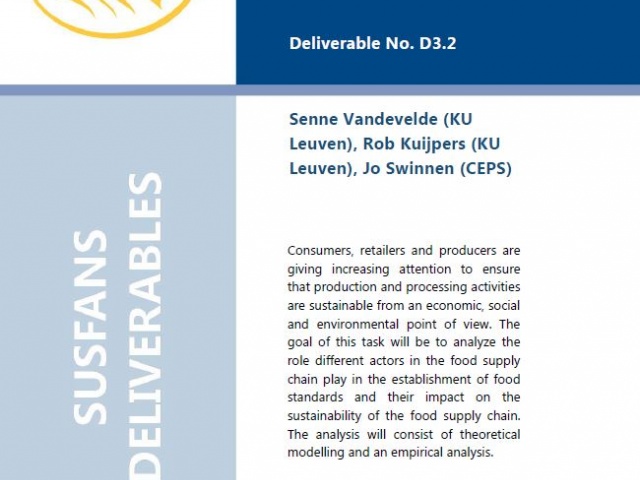
Deliverable 3.2: The role of different food chain actors on setting private food standards
Consumers, retailers and producers are giving increasing attention to ensure that production and processing activities are sustainable from an economic, social and environmental point of view. The goal of this task will be to analyze the role different actors in the food supply chain play in the establishment of food standards and their impact on the sustainability of the food supply chain. The analysis will consist of theoretical modelling and an empirical analysis.
Take a look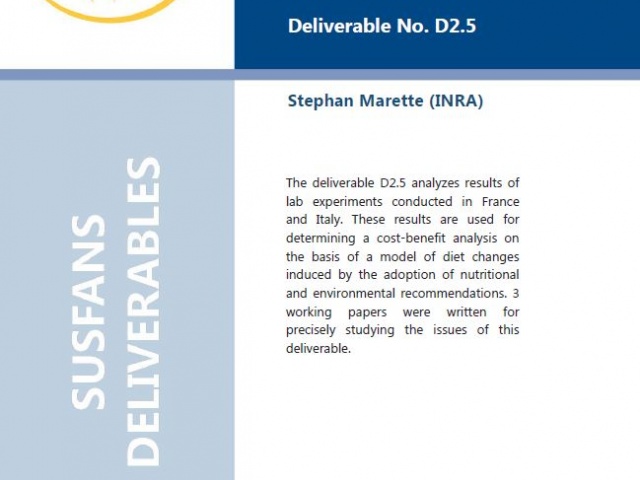
Deliverable 2.5: Consumer choice related to meat/fish consumption and their possible replacement by plant-based products: results from lab experiments and costbenefit analysis
The deliverable D2.5 analyzes the results of lab experiments conducted in France and Italy. We evaluate the impact of different types of information on participants’ willingness-to-pay (WTP) and quantity choices for both beef burger meat and soy burger meat. We conducted a lab experiment in France and Italy to elicit hypothetical WTP with a multiple-price list. Explanatory messages about the impact of beef and soy on health and environment were revealed to participants, before successive rounds of WTP determinations and quantity choices. Results show a very weak impact of successive rounds of messages on WTP for both beef and soy. However, these explanatory messages lead to a significant change in chosen quantities. These results are used for determining a cost-benefit analysis on the basis of a model of diet changes induced by the adoption of nutritional and environmental recommendations. We particularly show how both relative variations in willingness-to-pay (WTP) and relative variations in chosen quantities, following messages revealed in the lab, can be used for a welfare analysis. These variations are integrated in a market equilibrium model, as a possible demand shifter or as a non-internalized damage/benefit when consumers are ignorant. A related cost-benefit analysis studies the welfare impact of a nutritional recommendation or a tax mechanism. Results suggest that these regulatory tools have a significant impact on the variation of welfare and the reduction of beef consumption. 3 working papers provided in annex were written for precisely studying these issues of this deliverable.
Take a look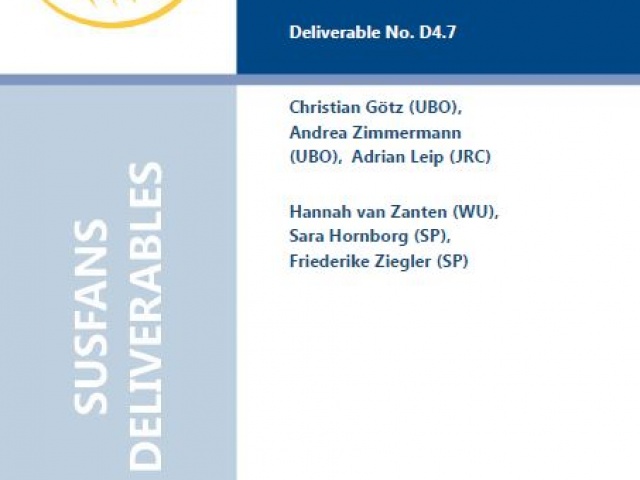
Deliverable 4.7: Database on farm-level production and sustainability indices for assessing sustainable diets
This paper demonstrates that SUSFANS metrics for assessing the environmental sustainability of the European food system can be effectively produced and applied to assess policy measures and potential innovations that aim at achieving sustainable food and nutrition security in the European Union. The analysis points at important issues that need to be taken into account for the further development and application of metrics.
Take a lookNewsletter 2
The second newsletter answers research questions like: "What do European consumers think about sustainable food?", "Can information beef up the demand for meat alternatives?" or "Can we bank on seafood for a healthier food consumption?" It gives short summaries of the deliverables and papers, published during the last month
Take a lookOperationalising the health aspects of sustainable diets: a review
Shifting towards a more sustainable food consumption pattern is an important strategy to mitigate climate change. In the past decade, various studies have optimised environmentally sustainable diets using different methodological approaches. The aim of the present review was to categorise and summarise the different approaches to operationalise the health aspects of environmentally sustainable diets.
Take a lookNewsletter 4
The fourth Newsletter includes a preview of the forthcoming Stakeholder Core Group workshop in June 2017. Furthermore, features of the latest three deliverables which have been published.
Take a lookDeliverable 4.3: Establishing a common accounting system for the LCA and emission leakage in the CAPRI model
The CAPRI model can be used in order to estimate GHG emissions from the agricultural sector in the EU. However, the calculation follows the logic of the UNFCCC framework, assigning emissions to production activities and the regions where those activities take place. In order to move from a production towards a more consumption oriented perspective we developed an LCA-module (Life cycle Assessment), both for EU and Non-EU regions, covering not only regional emissions but also emission leakage and worldwide emissions.
Take a look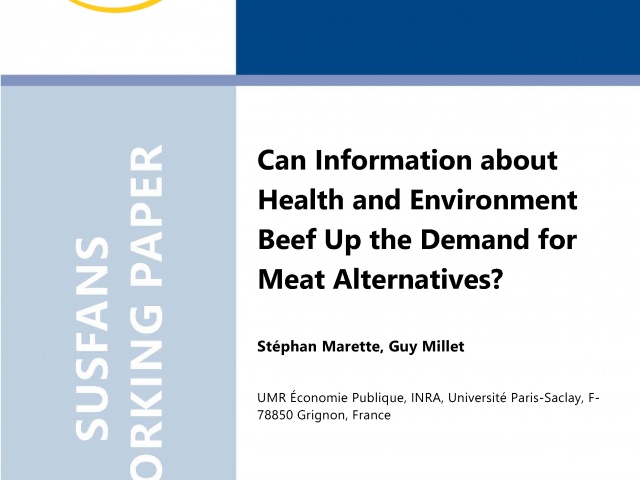
Can Information about Health and Environment Beef Up the Demand for Meat Alternatives?
A lab experiment was conducted in France to evaluate the impact of different types of information on participants’ willingness-to-pay (WTP) and quantity choices for both beef burger meat and soy burger meat. Explanatory messages about the impact of beef and oy on health and environment were revealed to participants, before successive rounds of WTP determinations and quantity choices. Results show that the different WTP for beef are not statistically influenced by the successive rounds of messages. Conversely, messages significantly increase the WTP for soy meat, even if this effect is relatively weak. These explanatory messages also lead to weak changes in the chosen quantities of beef and soy. A last round with the introduction of a high-quality beef leads to a statistically significant increase in the WTP for beef. Moreover, the selected quantities between beef and soy almost return to the initial quantities, namely the ones chosen before the revelation of messages. This reversal of chosen quantities towards more beef compared to soy underlines the participants’sensitivity to beef quality, when meat substitutes are considered.
Take a look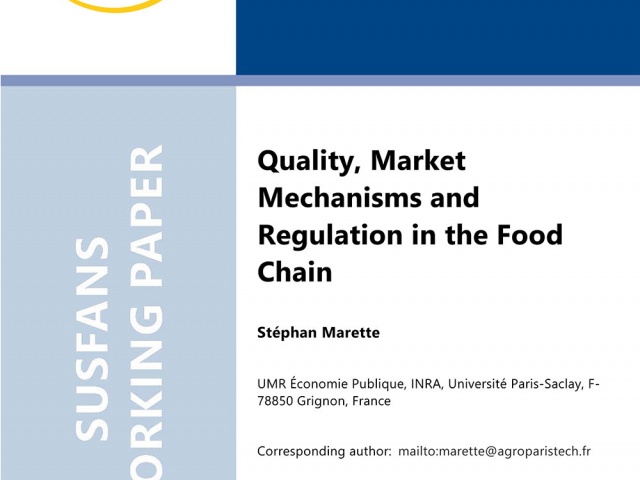
Quality, market mechanisms and regulation in the food chain
This paper focuses on questions related to the regulation of quality in the food chain. The paper first recalls the new challenges related to quality in the food chain, with an emphasis on the issue of sustainability. This first part underlines that the numerous dimensions related to sustainability make the regulation necessary but difficult. Then the paper introduces a partial equilibrium model calibrated with empirical data, for helping evaluate which regulatory instrument should be socially preferred ex ante on a case-by-case basis. An application to the milk market focuses on linseed for feeding dairy cows, which reduces methane emissions and increases the omega-3 content of milk. Simulations compare the impact of the exclusive use of one label signaling omega-3, versus the impact of a minimum-quality standard imposing linseed in the diet of all dairy cows. Both instruments would have a positive impact on consumers' surpluses and some producers’ profits. This application shows that details about the influence of regulatory tools on surpluses may be given on a case-by-case basis. Download as SUSFANS paper: http://susfans.eu/system/files/public_files/Publications/working_paper/Marette-Quality_Market_Mechanisms_and_Regulation_in_the_Food_Chain.pdf
Take a lookNewsletter 1
The first Newsletter of 2016 on project updates and informative SUSFANS research
Take a lookDeliverable 12.1 Consortium Agreement
Abstract: Strengthening food and nutrition security (FNS) in the EU requires a move towards a diet that supports sustainable food consumption and production. To gauge the policy reforms needed for this major societal challenge, the SUSFANS - consortium
Take a lookDeliverable 11.3 - First leaflet and press release
This deliverable embodies the first leaflet and press release. Results from Task 11.3. Dissemination materials include: a) two project leaflets, b) press releases on the project in English and translated into the partners‘ languages, c) two articles for specific magazines and relevant audiences, d) an entity poster or roll-up stand featuring the logo and key messages of the contract for use at booths and workshops, and e) a yearly electronic newsletter
Take a look